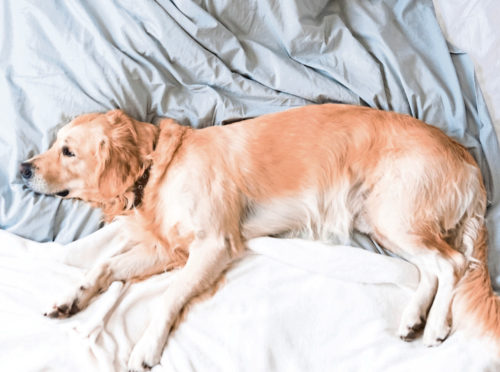
Many of us won’t even admit we let our pet cats and dogs sleep with us.
For the two-thirds of us who actually do, however, the shape we adopt beneath the covers can tell us a lot.
A study looked at 2,000 adult owners, and found that a third of them let their doggies or moggies sleep on the bed at their feet, in a position known as The Faithful for obvious reasons.
But how many of you have heard of The Wall or The Pillow Bandit, The Under-Cover Lover or indeed The Knee Nuzzle?
You may not think you’ve heard of it, but you may be adopting such a position each and every night.
Professor Peter Neville is a respected animal behaviour expert, and he carried out the study for Itchpet, pet wellbeing specialists.
“While The Faithful position may seem like the actions of a dutiful and worshipping dog, you’re horizontal in bed and so there is no respectful acknowledging posturing,” Peter points out.
“It’s more likely that you’re a restless sleeper and this is as close as he or she can be to you while keeping an easy escape route!”
What secrets lie behind the shape you take while sleeping close to your pet?
The Knee Nuzzle speaks volumes about the relationship between you both.
They reckon about 18% of pet owners adopt this shape, in which the pet nestles in the bend of your legs, with the human in the foetal position.
In this so-called artificial womb position, your pet is virtually handing all care over to you, almost as if he or she has become a kitten or puppy again.
It can literally sleep like a baby, in the knowledge you are keeping it safe and protected.
Our favourite name was The Donut Divider, in which your pet curls into a ball between your legs, the smaller furries liking this with the comfort of your legs either side.
It does, for obvious reasons, rely somewhat on you maintaining your position!
The other positive is, because cats and dogs can hear higher frequencies than us, and are thus more likely to be disturbed, getting between our legs can cut out unwanted noises.
The fourth most popular position is The Wall, in which your cat or dog will find a space between you and your partner.
This could obviously add to problems if the two humans would prefer not to have a large ball of fur between them, and many a pet will deliberately do this because they prefer one person over the other.
The Wall allows them to get closer to their favourite and keep the other person at a distance simultaneously.
Those of us who have struggled with dogs hogging certain cushions or specific parts of the couch will understand The Pillow Bandit.
When it comes to bedtime, many of them will hog the pillows, too, spreading themselves across a pillow because they love the comfort and softness and don’t see why this should be the preserve of humans.
“What’s clear is that sharing the bed with our pets is a normal part of our lives together and testament to the strength of the increasingly co-dependent bond between us and our cats and dogs,” Professor Neville points out.
“The main element of that bedroom relationship is based on comfort, enjoyment, touch, shared warmth and increased feelings of security for many dog owners especially.
“Cats regard us as mother figures throughout their lives when in close contact with us – predators outdoors, but forever ‘kittens’ when they cuddle up.
“Dogs, however, are more like 11-year-old humans in their social behaviour, often acting independently as guarders and hunters, but who all still find comfort and security close up with a parent figure or two when it’s time to sleep.”
The intriguingly-titled Under-Cover Lover, enjoyed by 9% of us, provides the ultimate dark den-style hideaway.
None of the noises or smells humans can be guilty of during sleep bother most dogs or cats, so many will happily snuggle up under the covers.
“When choosing their sleeping positions, our pets are broadly seeking to maintain and enhance their close protecting bond with us, rather than any desire to control us or monopolise territory,” says Professor Neville.
“But they do cleverly learn to use their appeal and the warm benefits they bring to us to train us to meet their individual night-time needs and desires and to shift our sleeping habits to accommodate theirs!”
And for us, the owners, 27% of us prefer having our pets in bed as their presence makes us feel less alone, while 37% love the warmth of their furry bodies.
There is also a certain feeling of safety and protection, of course, from having them around while we are in dreamland.

Enjoy the convenience of having The Sunday Post delivered as a digital ePaper straight to your smartphone, tablet or computer.
Subscribe for only £5.49 a month and enjoy all the benefits of the printed paper as a digital replica.
Subscribe